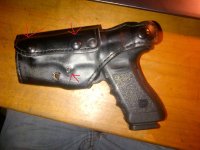Smithsrevenge
Member
- Joined
- Jun 26, 2013
- Messages
- 817
- Reaction score
- 889
So I've decided to turn a Safariland Model 200 Level 1 duty holster, Into a concealable OWB holster.
This is for my Glock 22 btw.
I've removed the paddle rig for the duty belt.....leaving me 3 connection points to mount another belt system to.
I tried modifying the duty belt hook up to no avail "this safariland stuff is TOUGH".
So basically. I want to take this holster, which was meant to ride about 2 inches away from the body on a duty belt. And convert it to ride close to the body, at a forward cant......as a normal OWB holster for concealment.
Attached is a pic of what im working with for mounting surfaces. The two bolts in the center of the holster are mountable. So is the one in the middle ish part of the holster. Upper bolt holds everything together and lower bolt is the retention screw.

Any help or ideas would be greatly appreciated.
This is for my Glock 22 btw.
I've removed the paddle rig for the duty belt.....leaving me 3 connection points to mount another belt system to.
I tried modifying the duty belt hook up to no avail "this safariland stuff is TOUGH".
So basically. I want to take this holster, which was meant to ride about 2 inches away from the body on a duty belt. And convert it to ride close to the body, at a forward cant......as a normal OWB holster for concealment.
Attached is a pic of what im working with for mounting surfaces. The two bolts in the center of the holster are mountable. So is the one in the middle ish part of the holster. Upper bolt holds everything together and lower bolt is the retention screw.

Any help or ideas would be greatly appreciated.
